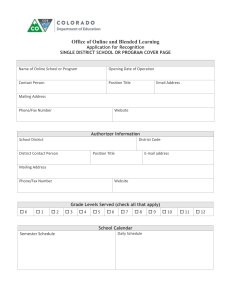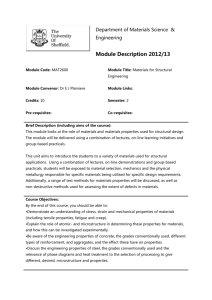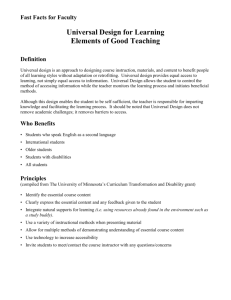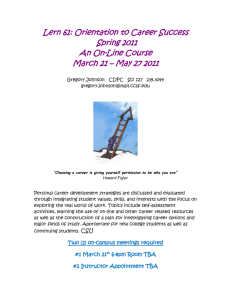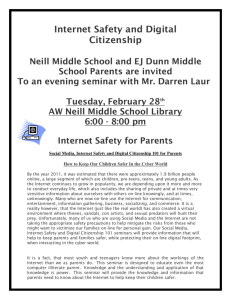Rites of Passage: Learning that counts! The Struggle Between the
advertisement
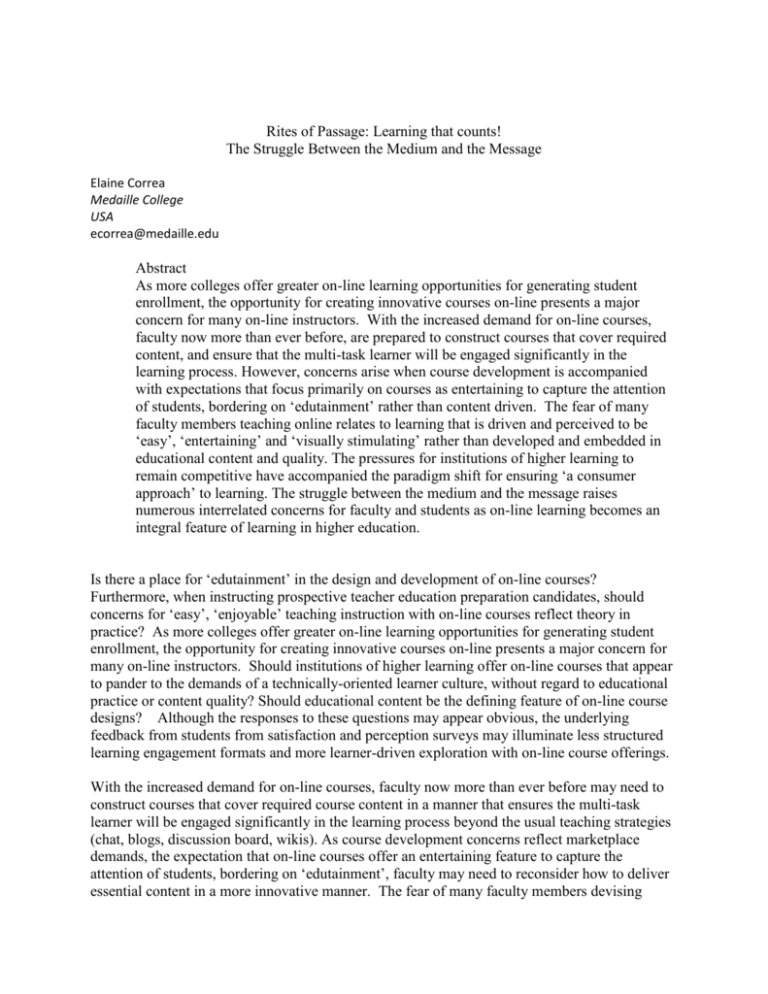
Rites of Passage: Learning that counts! The Struggle Between the Medium and the Message Elaine Correa Medaille College USA ecorrea@medaille.edu Abstract As more colleges offer greater on-line learning opportunities for generating student enrollment, the opportunity for creating innovative courses on-line presents a major concern for many on-line instructors. With the increased demand for on-line courses, faculty now more than ever before, are prepared to construct courses that cover required content, and ensure that the multi-task learner will be engaged significantly in the learning process. However, concerns arise when course development is accompanied with expectations that focus primarily on courses as entertaining to capture the attention of students, bordering on ‘edutainment’ rather than content driven. The fear of many faculty members teaching online relates to learning that is driven and perceived to be ‘easy’, ‘entertaining’ and ‘visually stimulating’ rather than developed and embedded in educational content and quality. The pressures for institutions of higher learning to remain competitive have accompanied the paradigm shift for ensuring ‘a consumer approach’ to learning. The struggle between the medium and the message raises numerous interrelated concerns for faculty and students as on-line learning becomes an integral feature of learning in higher education. Is there a place for ‘edutainment’ in the design and development of on-line courses? Furthermore, when instructing prospective teacher education preparation candidates, should concerns for ‘easy’, ‘enjoyable’ teaching instruction with on-line courses reflect theory in practice? As more colleges offer greater on-line learning opportunities for generating student enrollment, the opportunity for creating innovative courses on-line presents a major concern for many on-line instructors. Should institutions of higher learning offer on-line courses that appear to pander to the demands of a technically-oriented learner culture, without regard to educational practice or content quality? Should educational content be the defining feature of on-line course designs? Although the responses to these questions may appear obvious, the underlying feedback from students from satisfaction and perception surveys may illuminate less structured learning engagement formats and more learner-driven exploration with on-line course offerings. With the increased demand for on-line courses, faculty now more than ever before may need to construct courses that cover required course content in a manner that ensures the multi-task learner will be engaged significantly in the learning process beyond the usual teaching strategies (chat, blogs, discussion board, wikis). As course development concerns reflect marketplace demands, the expectation that on-line courses offer an entertaining feature to capture the attention of students, bordering on ‘edutainment’, faculty may need to reconsider how to deliver essential content in a more innovative manner. The fear of many faculty members devising courses and teaching online may relate to the expectation of learning as ‘easy’, ‘entertaining’ and ‘visually stimulating’ rather than course designs based on educational content and quality. The pressures for institutions of higher learning to remain competitive have accompanied the paradigm shift for ensuring ‘a consumer approach’ to learning. The struggle between the medium and the message therefore raises numerous interrelated concerns for faculty and students as online learning becomes an integral feature of learning in the politics of higher education. The “D.I.S. Factor”- Detachment, Isolation, Socially Disconnected In a room filled with young people, should one be surprised that exchanges and discussions are navigated or mediated through hand held devises rather than face-to -face interaction? Equally anticipated should the ease of exchange in cyber-space be expected to transcend into the realm of face-to-face interactions without any awkwardness and social uneasiness between individuals? How has the emergence of technology contribute to the social dis-function of human relations? To what extent can advancements and subsequently exchanges in cyber space be considered harmful to the moral and ethical development of human beings? In the course of ageing and development, are there rites of passage that must be anticipated in which individuals must experience a sense of detachment, isolation and being socially disconnected in order to learn? Must students disconnect from the world of 'wireless connectedness' in order to full engage and embrace learning? With the emergence of technology and socially constructed cyber-spaces, a shift in attitudes, expectations and learning appears to be a natural consequence of different forms of interactions and exchanges mediated through a connected space. No longer are the rustic vestiges of formal courtesy's or manners required as the recognition of an individual’s presence. Today, the teacher is replaced by a community of speakers whose audience may vacillate according to interest (tag line) and momentary attention span (speed of content delivery). The actual presence or acknowledgement of any person is negligible in such exchanges. In cases where the person is identified, the individual transforms from actual name to a colloquial expression or common greeting (hey,/ dude) or remains nameless as a part of a group of selected people or open list serve. Within such ‘connected spaces’ are we all ‘disconnected’ but engaged? In the case of learning in higher education, a further paradigm shift appears to occur unquestionably. The temporary nature of knowledge transfer rests less on the actual content and/or information that is garnered, and more on the sensational hype that accompanies the desire 'to learn' on a 'need to know' basis with quick one word posts (amazing!, how cool was that?). Information becomes important because other people are invested in these specific 'hot topics'. Outside the realm of learning, knowledge which is important rises to the top of the media news releases and streams into the hands of learners logged into their virtual worlds. This urgency for information or ‘need to know’, is framed in a collage of visual images, streamed through utube video pieces, or interconnected in virtual games, further advancing the hype component of learning to a level where the content becomes valuable only in so far as it is accompanied by all these addictive enhancements. The intrinsic value or merit associated with learning for knowledge acquisition or improvement is secondary, if at all a consideration. In such cases, what learning really counts? Undeniably, today, as advancements in technology provide greater opportunities for mobility as well as access to places, people and knowledge without extensive hours of travel time, waiting, or interference, many individuals may actually prefer this comfortable learning environment that feeds into all our basic needs unquestionably. With the acknowledgement of busy schedules and commitments that impose on our precious time, these adjustments, in some cases, or major metamorphosis in others, transform not only how students learn, but what types of learning can occur. Skype, for example, is used in numerous facets of life from business conferencing to exchanges in personal relationships. The opportunity to actually enjoy human contact like never before has reached unimaginable levels of advancement. Unlike the past when distances prevented people from physically meeting and connecting, today it is imaginable that people opt to meet in cyber space and share a short interaction rather than take the time to visit face to face over coffee or lunch. These types of exchanges provide for the communicating of ideas without leaving the comfort of the familiar. The needs of the learner are best addressed by the perspective of what the learner wants and how the learner prefers to learn. On the surface, these alternative learning arrangements enhanced by technology and supported by on-going technological advancements should not raise any concern since the benefits are obvious, with growing access and improvements to the instruments and tools that are used to fuel these diverse learning opportunities. Yet, problems do arise as diverse learning communities struggle between the medium and the message. Should educational content be delivered to learners in the format they feel most prepared to engage with and exchange? Should students be expected to move beyond their technical comfort zones towards less familiar traditional practices of learning? The current paradigm shift in teaching, aligned with rapid technological advancements based upon increasing access to both the construction and dissemination of knowledge, has contributed significantly to the unsettled terrain in which learning is expected to occur. Furthermore, the impact of a competitive marketplace entrenched in economic instability lends effectively to the mechanisms of ‘academic survival’ that have emerged within learning. This paradigm shift has influenced not only how students think about learning, but the attitudes, values and beliefs that students hold. Students today expect that education should be “fast, cheap and easy” which translates to “multiple delivery formats”, (fast), with, high economic educational value (cheap) and the expectation of student grade entitlement (easy). This shift in values and learning has become a critical component in contemporary North American educational discourse and culture. In an attempt to address the shift in values, given the context of changing educational priorities and the support and encouragement towards multiple delivery formats, an exercise of ‘reflective practice in action’ was identified by faculty in concert with students to address diverse competitive and often conflicting needs. As part of the reflective practice process, challenges and contradictions were identified and inverted into the ‘hotspots’ of teaching and learning in education. In an experimental teacher-learner format, student groups were asked to address a specific concern using a visual media format to raise awareness of the contradictions whilst challenging peers in the learning process. “Learning with and from each other” by working together to challenge and confront the contradictions that are apparent in learning invoked a number of interesting questions amongst students relating to power and authority, representation and identity, as well as what counts and is valued as learning. For faculty, these same issues were evident when discussions of revising on-line content and delivery were raised by students in evaluation of program offerings. The need to exercise ‘control’ and authority over courses related to the traditional paradigm of teacher as ‘expert’ and challenged the current system of who establishes what is valuable to learn and know. Additionally, as faculty addressed the types of changes that would advance and promote learning, the loss of control over the ‘classroom space’ within the context of the on-line classroom forced faculty to reconsider how theory reflects practice. The adage of ‘practice what you preach’ or ‘do what I say, not what I do’ became apparent mirrors for reflecting on the fear and awkwardness experienced by faculty when required to engage in technology training outside their discipline content area where they were ‘experts’. The struggle between the medium and the message were apparent for both faculty and students as opportunities to reflect on current teaching and e-learning practices forced recognition that ‘old habits’ take time to break. As the ‘rites of passage’ were initially seen as the fundamental steps for students to assume in their learning, these same ‘rites of passage’ became apparent for faculty when reflecting on balancing the revisions to their on-line courses and undergoing appropriate training to improve their course delivery for current technology-based learners. The struggle with validating the different ‘mediums’ of instruction or modes of learning continues to remain a controversial position in higher education, particularly given the ‘consumer approach’ adopted by administrators in defining the direction of colleges. However, the underlying message of learning and the importance of teaching courses embedded in educational content should continue to be the basis of instruction, regardless of the delivery format. The rites of passage as to what learning counts will continue to be challenged as new advances and technologies are devised. The difference, hopefully, will be in how teachers and learners embrace different forms of learning to ensure that effective learning occurs. References Correa, E. & Centrie, C. (2006). ‘The Shift from Teaching to Entitlement Learning’. Comparative and International Education Society Paper Presentation. (March 19-23) Hawaii: U.S.A. Duffy,T, & Kirkley, J. (2004). Designing Environments for Distributed Learning: Theory and Practice. Mahwah: NJ: Lawrence Erlbaum and Associates. hooks, b. (1994). Teaching to Transgress. New York: Sister Vision. Friere, P. (1970). Pedagogy of the Oppressed. New York: Seaview. Mirochnik, E. and Sherman, D. (Eds.) (2002). Passion and Pedagogy. New York: Lesley University Series in Arts and Education. McLuhan, M. (1998). The Method is the Message. Montreal: Black Rose Books. Shor, I. (1992). Empowering education: Critical Teaching for Social Change. Chicago: University of Chicago Press.

